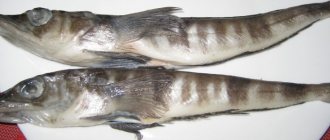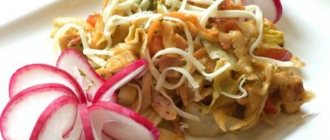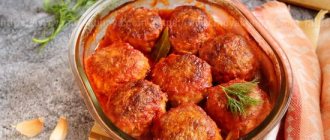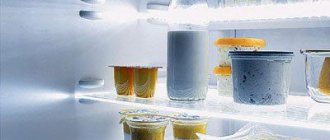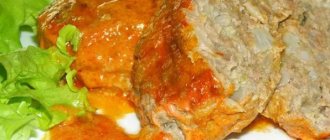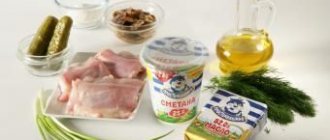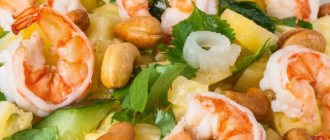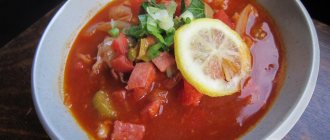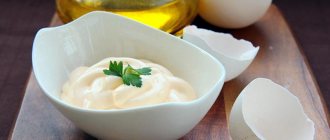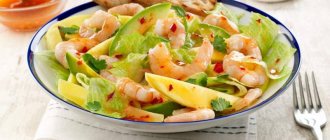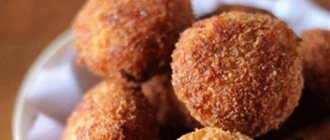Step by step recipe
Preparing the fish
A pleasant moment
In general, this fish is very convenient to work with; it is sold without a head and already gutted, so it will take very little time to prepare. Especially for those who are in a hurry to cook.
Wash the fish under cool water and remove scales. The navaga is small and easily separated. Let's look into the abdomen, remove the black film and the remains of the entrails. Rinse again with water and dry a little with a paper towel to remove excess water.
If the navaga is small, you can bake it whole. I had quite large specimens at my disposal. Therefore, I will cut the navaga into convenient portions, as in the photo, and then rub it with salt and you can sprinkle it with fish seasoning. Let's leave the navaga to salt in a dark, cool place. About ten minutes will be enough.
Peel the onion, rinse with cool water and chop into half rings using a sharp knife or any suitable kitchen gadget.
How to deliciously bake navaga with onions
Turn on the oven in advance to preheat to 180 degrees.
Carefully roll each piece of fish in flour and place it on a baking sheet greased with colorless and odorless vegetable oil. We do not place the fish tightly, but at intervals, which we then fill with chopped onions.
Navaga in the oven: how long to bake
Place the pan in the oven for 30 - 35 minutes. During this time, the fish will cook and even brown nicely, and the onion will fry almost like in a frying pan.
We serve delicious “navaga in the oven” with any side dish or simply with fresh vegetables. I prepared classic mashed potatoes in advance, especially for this dish. Do you agree, what could be tastier than fish and potatoes? Bon appetit!
A few more recipes for Navaga in the Oven
What do you need to know about cooking navaga?
Currently, more and more housewives are looking for a suitable recipe for navaga fish in the oven. What kind of sea creature is this anyway? Navaga comes from the cod family. But unlike its relative, it has a low cost, which explains its popularity.
In addition, navaga is considered a low-calorie product, because 100 g of baked fillet contains barely 75 kilocalories. But another advantage is the almost complete absence of fat. From a serving weighing 100 g, only one gram is allocated to fat. And everything else is easily digestible proteins, as well as fatty acids, vitamins, mineral compounds, micro- and macroelements.
Navaga is prepared in different ways. It can be fried, baked, stewed, steamed or grilled. The taste will be amazing in any case. And if you are convinced that navaga is tasteless, it means you simply haven’t learned how to cook it correctly.
Most often, culinary experts prepare navaga in foil in the oven. The recipe is simple, one might say classic. All you need to add is salt, ground allspice and freshly squeezed lemon juice. You should be most responsible when it comes to preparing the fish, and your table will have an appetizing aroma of delicious fish treats.
On a note! Cod fillet has a dense consistency, which makes it possible to subject it to various types of heat treatment. Even if you overcook the fish in the oven, rest assured that it will not break into small pieces on the plate.
The recipe for navaga in the oven with vegetables is very popular. The taste of navaga allows it to be combined with various vegetable ingredients, but traditionally carrots and onions are added to the fish, which are pre-sautéed in refined oil of sunflower seeds or olive fruits.
Cook's tips:
Navaga can not only be baked. The fillets of this sea fish from the cod family are used to prepare amazing fish soup and solyanka. You can safely include this product in your diet due to its low calorie content. It’s just better not to add fatty sauces when baking. The best option is lemon juice, salt and a mixture of ground peppers.
Every chef and experienced housewife knows how to cook navaga. And if you claim that the fish is not tasty, then you have never managed to master this culinary lesson. We invite you to bake navaga according to a simple recipe. The dish will turn out extremely tasty, and its amazing aroma will not leave anyone indifferent.
On a note! If the recipe calls for sour cream, you can replace it with cream. It is better not to use mayonnaise, as this will affect the taste of the prepared treat.
Ingredients:
- Fresh frozen navaga – 1 kg;
- sour cream with an average percentage of fat content - 4-5 tablespoons. spoon;
- onion - three to four heads;
- refined sunflower seed oil – 1 table. spoon.
Preparation:
If you bake navaga with vegetables, you don’t need to add sauce. But in this case, it is advisable to cover the heat-resistant form with foil so that the contents do not dry out and the fish is evenly baked. Before cooking the whole navaga, transverse cuts are made on the carcass, which can be filled with lemon slices, pieces of hard cheese or fresh tomatoes.
Navaga is a fish from the cod family that has a pleasant taste and many beneficial properties. This inexpensive product will have a noticeable impact on your health when prepared correctly. Let's find out what the benefits and harms of navaga are, who is especially recommended to use it, and how to choose and prepare fish correctly.
Flounder with potatoes in the oven in foil
This cooking method is the most common; the fish comes with a ready-made side dish. During cooking, the potatoes acquire notes of flounder in addition to their taste.
The recipe includes:
- fish carcass – 600-800 g;
- coriander – 20 g;
- dill seeds – 20 g;
- potatoes – 500 g;
- paprika – 20 g;
- sunflower oil – 60 ml;
- salt, allspice - 20 g each.
Recipe technology:
- The fish is processed. Remove the head, entrails and fins.
- In a small bowl, combine salt, paprika, dill seeds, allspice and coriander. The mixture is poured with oil and stirred until smooth.
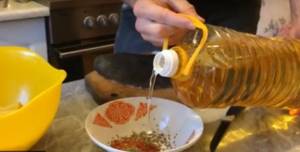
- Potatoes are cut into strips (like fries).
- Several longitudinal cuts are made on both sides of the flounder. Rub the surface and inside with a mixture of spices.
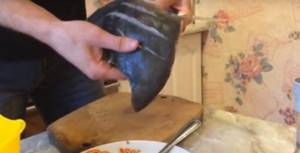
- The fish is placed on a baking sheet and greased with oil around it.
- Pour the remaining mixture into the potato slices and mix.
- Arrange the vegetables around the fish and cover with a sheet of foil.
What kind of fish is this
Navaga is a small, spotted, olive-colored fish. It lives in the cold waters of the Far Eastern and northern regions. There are two types of navaga:
- Northern. Habitat: White, Kara and Barents Seas. Its size does not exceed 30 cm. The meat is more soft and tender. This type of fish was primarily caught for industrial purposes.
- Far Eastern. This fish is larger than the northern one and lives in the Bering, Chukchi, Okhotsk and Japan seas. Another name for this variety is “vahnya”.
In general, these two types are similar in taste. Fish caught in late autumn or winter has the best taste.
Why is navaga useful?
Navaga has many beneficial properties for the body, including:
- Maintaining the immune system and nervous system, which is ensured by the presence of selenium in the composition.
- Prevention of cell aging thanks to vitamin E.
- Strengthening the skeletal system, which vitamin D helps with.
- Ensuring healthy skin and visual acuity with vitamin A.
- A beneficial effect on cholesterol metabolism and fat synthesis, which is provided by unsaturated fatty acids in the liver of navaga.
- Increasing resistance to stress, improving brain function and normalizing sleep patterns.
- Of particular importance is folic acid, which helps in the formation of red blood cells.
Now let’s look at what specific diseases may be indications for using the product.
For what diseases is navaga fish useful?
- Hypertension and other cardiovascular problems. Omega-3 fatty acids in meat are useful for proper heart function, stabilizing blood pressure and heart rate.
- Thyroid dysfunction, which vitamin D and iodine help normalize.
- Navaga has a beneficial effect on the children's body, preventing rickets.
- Fatty acids also help prevent cancer: kidney, liver, colon, breast and prostate cancer.
- Regular use of the product improves mental health, smoothing out the symptoms of depression, bipolar disorder and other disorders.
Is navaga good for pregnant and lactating women?
The benefits of navaga have also been proven for the body of pregnant women. The product contains docasahexaenoic acid. It is useful for the development of the brain, visual apparatus and central nervous system of the unborn child. Doctors recommend that pregnant and lactating women consume up to 200 mg of this acid per day.
Fish is also useful when there is a threat of miscarriage - regular consumption of it helps maintain pregnancy. , iron and iodine at the cellular level protect the fetus from environmental harm. Eating fish during pregnancy will help prevent postpartum anemia. In the first month of lactation, it is advisable to avoid the product to avoid a possible allergic reaction.
Flounder in the oven with crab meat
A recipe for true connoisseurs of sea fish.
Ingredients for 4 servings:
- flounder fillet –700 grams;
- crab meat – 1 cup;
- paprika – 1 fruit;
- saltine cracker - 3 pieces;
- egg - 1 piece;
- butter – 1/4 cup;
- Worcestershire sauce - 1/4 tsp;
- mustard powder - 1/4 tsp;
- mayonnaise – 1 tbsp. l.;
- paprika - 1/2 tsp;
- salt – 1/4 tsp;
- pepper – 1/4 tsp;
- dried parsley – 1 tbsp.
100 grams of the finished product contains:
calories – 140;
proteins – 16;
fat – 7;
carbohydrates - 3.
Preparation time - 15 minutes
Preparation – 30 minutes
- Rinse the fillet and drain the water. Blot off excess with a napkin.
- Grind bell pepper, crab meat, crackers.
- Add Worcestershire sauce, salt and pepper to the mixture.
- Mix the egg white with a spoonful of mayonnaise and stir into the crab mixture.
- Brush the fillet with butter. Place in a baking dish. The crab filling is carefully laid out on top.
- Preheat the oven to 200 degrees and bake for fifteen minutes.
- Beat egg yolk with mayonnaise.
- Pour it over the crab filling. Sprinkle with parsley and paprika.
- Place in the oven for another fifteen minutes until golden brown.
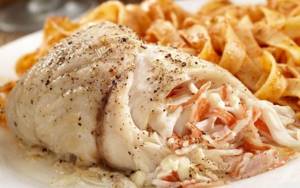
How to cook delicious navaga
There are many ways to prepare a dish that differ in complexity and taste. Let's look at some of them:
- One of the most delicious and common dishes is fried fish. In order for the navaga to retain its juiciness and tenderness, it must be removed from the stove a couple of minutes before it is ready - the fish will finish cooking in a hot frying pan. When frying, many harmful carcinogens are formed, so it is better not to overuse fried fish.
- Navaga stewed in sour cream turns out tender and tasty. For a thick consistency, you can add a little flour to the sour cream. Sautéed onions and carrots will add a special taste to the dish.
- Ear soup will be beneficial for digestion. To keep the meat firm, you need to cook it over low heat.
- Cutlets are also made from navaga. To add juiciness to the dish, it is recommended to mix minced fish with breadcrumbs, which absorb and retain moisture.
- The most useful cooking method, suitable for diet and healthy eating, is boiling or steaming. To make the fish tastier, you can add your favorite spices when cooking, and sprinkle with herbs when serving.
This fish is suitable for lunch or dinner. It goes well with potatoes, rice, and fresh vegetable salads.
Flounder in the oven PP recipe
Dietary fish dishes can also be delicious. And if you remember the words of the poet: “Don’t take away from the beneficial properties, / It’s time to cook and eat!”, then flounder in the oven is the best recipe for lovers of proper nutrition. An appetizing low-calorie dinner for PP lovers, prepared in a hurry. Recipe with calorie calculation step by step.
Ingredients for 4 servings:
- flounder – 4 medium-sized pieces;
- lemon – half a fruit;
- basil - to taste;
- olive oil – 4 tsp;
- salt, pepper - to taste.
100 grams of the finished product contain:
calories – 100;
proteins – 22.7;
fat – 0.9;
carbohydrates – 0.2.
Preparation time - 15 minutes
Cooking time – 15 minutes
- We need to cut up the fish. If necessary, remove scales. Make a V-shaped cut and carefully separate the head along with the entrails from the body.
- The tail and fins are cut off with scissors. This saves space on the baking sheet. This will not affect the appearance of the finished dish.
- To ensure even baking, cut the dark side several times with a knife.
- Prepare four separate sheets of foil and grease them with oil.
- Place the fish and sprinkle with basil.
- Season with pepper, salt, and sprinkle with oil.
- Squeeze the lemon.
- Do not cover the fish completely with foil, but just fold the edges up.
- Preheat oven to 200 degrees.
- Bake in the oven or under the grill.
- Serve directly in foil on a beautiful plate.
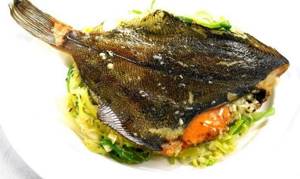
How to choose and store navaga correctly
When choosing fish, it is important to focus on the following recommendations:
- You should not take a product that already has too much ice on it. This means that the fish has been frozen and thawed multiple times.
- The belly of fresh fish should be white. A yellowish tint indicates the beginning of the oxidative process of fats.
- The eyes of a quality fish should not be cloudy.
- High-quality meat from gutted fish is white, but not grayish.
It is advisable to prepare the fresh product immediately without freezing. However, if this is not possible, then it can be stored at a temperature no higher than –18 °C. Once you have thawed the fish, you should not refreeze it.
Why should you choose navaga?
Navaga has more tender meat. It does not have a pronounced odor. The high content of vitamin PP in fish has a positive effect on the physical condition of the body and has a beneficial effect on mental activity.
This type of fish belongs to the category, but it contains fatty acids, with the help of which cholesterol can be neutralized. Navaga is especially tasty when cooked in the oven with vegetables such as potatoes, zucchini or cauliflower.
Whole flounder in the oven
Small specimens are best baked whole. However, large fish is also suitable; flounder meat turns out juicy. The recipe is suitable for baking in a sleeve and foil.
Required:
- Flounder carcass – 1.5 kg.
- Sunflower oil - spoon.
- Butter - spoon.
- Lemon.
- A bunch of parsley with dill, pepper and salt.
How to cook tasty flounder:
- Remove the butter from the refrigerator until it softens a little.
- Cut the fish, removing the entrails, head and fins.
- Place the light side up on the board and make several cross cuts. 2-3 is enough, depending on the size of the carcass.
- Mix pepper and salt. Rub the mixture onto the fish, making sure to get the spices into the slits.
- Place in a bowl and sprinkle with juice from ½ of a lemon. Set the workpiece aside for a quarter of an hour.
- Turn on the oven, heat to 220 o C.
- Divide the remaining lemon into slices.
- Grease a baking sheet with vegetable oil and place the whole flounder.
- Place the baking sheet in the oven. Bake for 25 minutes first.
- Remove the fish and insert lemon slices into the slots.
- Bake again for 25 minutes.
- While the dish is cooking, chop the greens and add to the butter. Mix the mixture thoroughly.
- Remove the flounder from the oven and remove the lemon wedges. Coat with oil and dill mixture. And return to bake for 2-4 minutes.
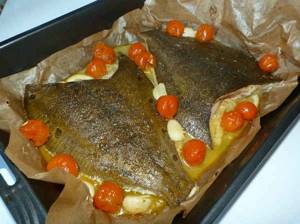
Recipe with vegetables
If cooked with navaga vegetables, recipes for cooking in the oven should contain the following list of ingredients: onions, lemon, tomatoes, sunflower oil, salt, fish. First you need to prepare all the ingredients.
Whole carcasses are gutted and scaled. Then they are cut into portions.
The fillet can be left whole. Then the vegetables are chopped. Tomatoes are cut into thin rings. Onions are also chopped into rings. The lemon should be squeezed out. The recipe uses half the fruit.
When navaga is placed on a dish, cooking recipes with photos show in detail all the stages. First you need to place the tomatoes on a baking sheet. , onions are sprinkled on top. Finally, pour the dish with vegetable oil and lemon juice.
Before baking, cover the pan with foil and place in the oven. The dish is ready in 15-20 minutes. Finally, remove the foil to create a delicious crust. The food is served 5-10 minutes after the oven is turned off.
Flounder baked in the oven - a simple recipe
Flounder is a very useful and tender fish, but a little capricious. Not every housewife will be able to fry flounder in pieces and keep these pieces safe and sound. This fish really loves to stick even to non-stick pans. But in this recipe this will not happen, because we will not fry the flounder, but bake it, and even the whole one. Baking a whole flounder in the oven is so easy that anyone can cope with this task :).
Cooking flounder in the oven is the best way to preserve all the beneficial properties of this fish without losing its taste. I want to offer you a recipe for cooking flounder in the oven, which will not require high culinary skills or rare ingredients, but will delight you with an excellent result.
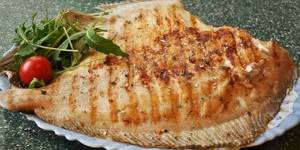
Products:
- Flounder 1 piece (1-1.3 kg)
- Lemon 1 piece
- Vegetable oil 2 tablespoons
- Salt to taste (≈1 level teaspoon)
- Ground black pepper to taste
- Butter 1 tablespoon melted
Recipe:
Wash the fish thoroughly and let the water drain. Place on a large cutting board. Using culinary scissors, cut off the side fins and tail. Using a knife, make portion cuts on the light side. I make deeper cuts, breaking the spine, but not cutting all the way, just so that I can easily divide it into portions. If you don’t do this, then it will be much more difficult to beautifully divide ready-made fish into pieces. This is especially important if you caught it in a store
